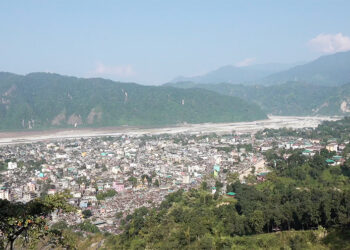 As tens of thousands gather at the Changlimithang ground for the closing ceremony of the Global Peace Prayer Festival, a sacred cultural display at the Centenary Park drew special attention. The De-suung Skilling Programme showcased two Tashi Gomang, which are portable shrines, brought from Paro and Trongsa, reflecting Bhutan’s deep spiritual and artistic heritage.
As tens of thousands gather at the Changlimithang ground for the closing ceremony of the Global Peace Prayer Festival, a sacred cultural display at the Centenary Park drew special attention. The De-suung Skilling Programme showcased two Tashi Gomang, which are portable shrines, brought from Paro and Trongsa, reflecting Bhutan’s deep spiritual and artistic heritage.
A Tashi Gomang, literally meaning “stupa of multiple auspicious doors,” is a multi-tiered, three-dimensional mandala, a wooden shrine adorned with dozens of tiny doors that open to reveal hundreds of sacred paintings and statues.

“The Tashi Gomang of Trongsa is of the Zangdo Pelri type, with the main relic being the statue of Chenrezig. It is one of the oldest Trashi Gomang. While most paintings and relics are similar, the Tashi Gomang of Paro is of the Jangchub Chorten type,” said Thuba, Manip, Trongsa.
The display remains open to the public from 8:30 in the morning until 5:30 in the evening.
Historically, these shrines were carried by wandering religious practitioners known as manips, who travelled across the country to bless communities and spread merit through their spiritual practice.
During the display, four manips chanted “mani,” a core part of their devotion, filling the park with spiritual resonance.
“Along with the Global Peace Prayer Festival, the De-suung office requested the Central Monastic Body for the display of the Tashi Gomang. It is said that witnessing the Tashi Gomang is equivalent to earning the merit of building 108 temples,” said Tshering Dorji, Coordinator, Zhung Dratsang Preservation and Antiquities Conservation Centre.
Coordinators hope such displays will inspire younger generations to preserve and carry forward Bhutan’s sacred artistic traditions.
“One of the main reasons behind this display is to preserve and promote our cultural traditions. Another is that many of our youths, both within and outside the country, have never even heard of the Tashi Gomang, let alone understand its significance. We hope that they know about it now,” said Karma Phuntsho, Programme Manager, De-suung Skilling Programme.
The display of the Tashi Gomang serves as a powerful symbol of Bhutan’s enduring spiritual heritage and a reminder of the importance of preserving these sacred traditions for future generations.
Namgay Wangdi
Edited by Phub Gyem










